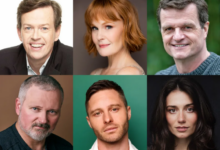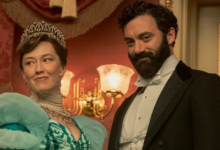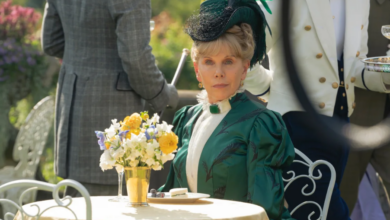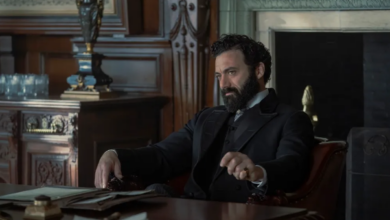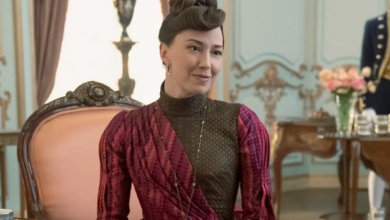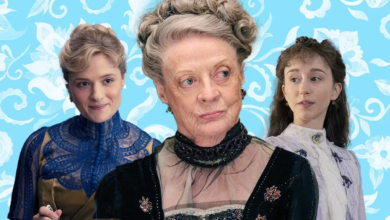Interview: Production Designer Bob Shaw on ‘The Gilded Age’
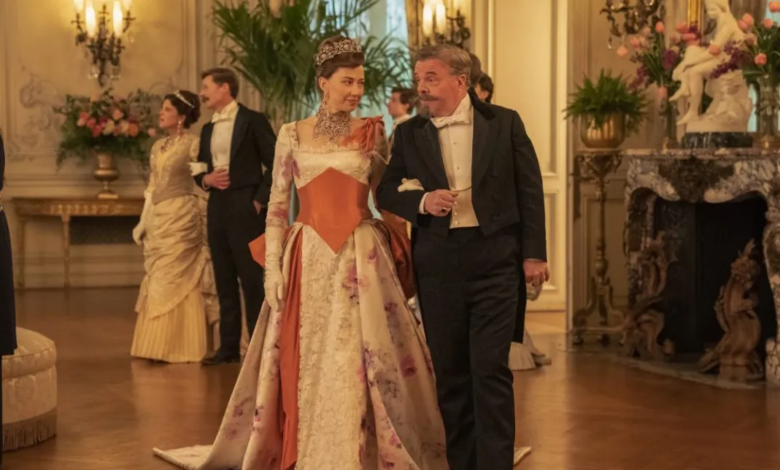
On The Gilded Age, production designer Bob Shaw has the tough job of transporting us back to a time in the 20th century when robber barons reigned, and opulence was the nom de jour. His detailed, intricate, and absolutely beautiful work is part of why the show is so immersive. But if you know Shaw’s career, this is not a surprise. Not only has the production designer been nominated for an Oscar for his work on The Irishman, he’s won Emmys for his work on the first season of The Gilded Age, art direction on Boardwalk Empire, and on Mad Men. Over Zoom, we talked to him about building out the world in season 2 of the MAX show.
Shaw talked about his love of New York history and his knowledge of the oh-so-important to season 2 opera wars, is part of what got him the gig on the show in the first place. He talked about using different materials to distinguish between the old and new money on the show and how that has a basis in what it really was like at that time period. Shaw shared how scouting trips to Newport, Rhode Island, influenced some of the scripts, including the big green Newport Casino. Season 2 has many impressive design feats, one of which is turning the Philadelphia Academy of Music into the Metropolitan Opera House. Shaw shared just how they did it. Read on for the full interview or listen to the audio below.
Ayla Ruby: And I would love to know, obviously there’s all the history, but what drew you into this world? What made you think, “I have to do this”?
Bob Shaw:Well, when it came up, I’ve always been a New York history fan and I know a lot about some of the background and when I heard that Julian was doing the show, it was like, “Please, please let me be the one.” And when I went to meet, I asked certain questions like, “Well, are you going to get into the opera wars which of course, we got into it in Season 2. And I think the fact that I knew a lot of the history already and certain things about Alva Vanderbilt and the Vanderbilts. I mean, I had three or four shelves in my home library just on New York history.
Ayla Ruby: Oh, wow. So much of the story, and I feel like so much of the characterization of just the people we’re watching is told by the production design, these giant houses, the interiors. It’s amazing. And I would love to know, can you talk about a little of collaborating with Julian Fellowes, Sonja Warfield to figure out, you’ve got words on a page, how do you get from that to what you have?
Bob Shaw: Well, it’s interesting because when I first talked to Julian, he mentioned that he liked the Duke Mansion and I thought, “Oh my, that’s 30 or 40 years later than our story.” And Michael Engler, our primary director, was saying that, “Well, I don’t want any turrets.” And that was a very prominent feature on the Petit Chateau, which was the Alva Vanderbilt mansion. So you get feedback from a lot of different people and then you try and put it all together and make sense out of it. Then there are certain things that are just staging things, like the size of the Great Hall in the Russell House and trying to have a landing at the top of the stairs, which isn’t very common because when someone appears, sometimes the staircases are in a certain position, they walk from behind and they don’t have a real way to present themselves. I think I cribbed from the Metropolitan Club, which of course isn’t a private home, but it’s Stanford White, so I figured it qualified because he’s supposedly the architect of our mansion.
Ayla Ruby: Oh, that’s right. I didn’t make that connection.
Bob Shaw: I call it Newport’s greatest hits sometimes because the floor is copied from Marble House, in the dining room where there are columns that have the light fixture attached to the columns, that’s taken from The Music Room of The Breakers, there are certain textures on the wall that are taken from Ochre Court, so you can cherry pick all your favorite details in the different mansions.
Ayla Ruby: It’s obviously a very, very different house than the van Rhijn house. How do you, I guess, characterize their house?
Bob Shaw: Well, I always say that the old money, which is the Brooke and van Rhijn House, wanted to be English, and the new money wanted to be French, and everything was darker in that old money world. It was a thing that the houses were all brownstone. Edith Wharton famously said that it looked like the entire city was dipped in chocolate because it was all the same and uniformity, and it was tribal almost, the old money, and it was considered vulgar to display your wealth on the street. So everybody’s houses looked more or less the same, and you had to go inside, be one of the privileged few, in order to even see what they had on the inside. Then everything’s much lighter area, more French things were made of stone instead of brownstone, marble, limestone and materials historically were just very, very different. And that alone makes a big contrast between the houses.
Ayla Ruby: Now in season two, outside of the houses, you get to go different places. There’s Newport, there’s the casino in Newport, there’s all these different, I want to say styles of worlds. Can you talk about bringing them to life? And I keep thinking of just the big green casino because I just thought that was really cool. What was-
Bob Shaw: Well, there are certain things that were not originally in the scripts even. And then when we started doing some scouting and going to Newport, and I had gone before, we went as a group and things that we just wanted to see. And I said, “Well, you can’t really be in Newport and not see the casino.” And so as soon as we saw the casino, and Julian was aware of the casino, they wrote scenes for it. In Season 1, we had toured The Breakers, which of course is the most famous of the Newport cottages. It has this spectacular billiard room. And from the moment we saw it, it was like, “Well, I don’t know what’s going to happen here, but we’re going to definitely have to put scene here.”
And since we only show the entrance hall, the drawing room, the library and the dining room of the Russell Mansion, everyone knows that there would be many other rooms. So we thought we could claim that enormous billiard room was somewhere toward the back of the set. There was just a checklist of things people had to have. It was very popular to have, what they would call a Turkish or a Moorish room at the time, which was usually the smoking room.
Ayla Ruby: I could see that.
Bob Shaw: I’m sorry, there’s some people yelling in the background.
Ayla Ruby: That’s okay.
Bob Shaw: Yeah, that’s the art department. I don’t know what they’re doing out there.
Ayla Ruby: You’ll find out soon.
Bob Shaw: Hopefully they’re enjoying themselves in a productive way. So we actually had to push the style of our houses, certainly the Russell House, a little bit forward in history because we knew that we were going to incorporate the mansions of Newport, which were mostly built in the 1890s. And believe it or not, there was quite a difference from the early 1880s style to the 1990s, 1890s rather. And things like the railings on the stairs would’ve been stone in 1882 and they were all metal in the 1890s. And since we had to make it all look like it was the same world we had to cross-referenced the materials.
Ayla Ruby: I believe it. I mean, even now there are massive differences between decades of just normal houses built in the ’80s compared to the ’90s, or you can tell.
Bob Shaw: Yeah.
Ayla Ruby: So you mentioned the Opera Wars earlier and obviously Season 2 deals with the Opera Wars, and as part of that is this big Metropolitan Opera House. Can you talk about how you accomplished that? I read something about three locations.
Bob Shaw: Well, were multiple locations. The funny thing is, in the first season, the only thing written was the Academy of Music and Michael Engler and Julian were in Philadelphia for a press junket for the Downton Abbey movie. And they said, “Would you come down and look at the Philadelphia Academy of Music with us?” And I said, “Okay, I have a question,” When we were in there, “Are you going to get into the Opera Wars in Season 2?” They said, “Well, then we can’t use this for the Academy of Music because there’s nothing else in this country that resembles a European-style opera house other than the Philadelphia Academy of Music.” So we made that decision and it’s like, “Great, it looks great.”
And then we realized, “Oh, it doesn’t really have a ring of boxes,” which is the most important thing in the plot and one of the most important characteristics of the Met. So we built five opera boxes on a curve. They were about 20 feet in the air, and then there was a green border around the whole thing. And visual effects had to, I say, slide it between the first and second balconies of the Academy of Music as if it were a giant cassette and just plug it in. So we had to take measurements and be very, very careful about everything because there are columns and the columns on our set had to line up perfectly with the columns at the academy.
Ayla Ruby: So I’m from Philly and I know that building very, very well. So I’m just trying to picture this and-
Bob Shaw: Well, they have the double columns on either side of the proscenium and each one has two boxes in it, but those are the only boxes in the house.
Ayla Ruby: No, and obviously it looks very, very different in the show, so kudos to you because it completely worked.
Bob Shaw: Well, and to the VFX team did an amazing job.
Ayla Ruby: …and I wanted to talk about about the mills in Pittsburgh too, the Pennsylvania connection. This is very different than anything else we’ve seen so far in The Gilded Age. It’s grittier, it feels very open and I’d love to know more about-
Bob Shaw: It’s important to be getting into that. And we film a lot in the Troy in Albany area and the town between the two of them is Cahoes, which was a mill town, but it was textile mills, not steel. So some of the buildings were there and the structures were there, but the VFX team again had to change the windows and make them these large steel mill windows instead of little hung windows that you would have on a textile mill. So we were fortunate that it was just there. And even when they go to see Henderson’s house, that was actually factory housing that existed at the location from when the mill was functioning. Again, it had been modernized a little bit, so we had to make changes and put dirt on the street.
It’s always a very popular thing to be negotiating, to shoot in someone’s area and then say, “Oh, by the way, it’ll only be there for a couple of weeks, but can we put dirt on your street?” The first year we did Monument Square in Troy and they were like, “Sure, you can take this triangle that is the center of town and cover it with dirt for a month. That’ll be fine.” We’re lucky that people get excited about the filming.
Ayla Ruby: It’s always wonderful to see. And I think the show is amazing. So that’s probably part of why because they know it’s going to look really cool.
Bob Shaw: Well, I mean, certain historic properties can be afraid when you approach them to do filming because they have a lot of very valuable and very delicate possessions. To their credit, the Preservation Society of Newport instantly saw an opportunity and they said, “Well, this goes,” and now when you go to Newport, all of their promotional stuff says, “Visit The Gilded Age.” And some places, we shoot at Lyndhurst and Tarrytown, which was the Jay Gould mansion, and they say they’ve had an uptick in visits since they’ve appeared on the show.
Ayla Ruby: I believe it.
Bob Shaw: We’re very happy to do anything we can to aid these historic properties.
Ayla Ruby: Now, there was also a really cool church that was used in Ada’s wedding, and I’d love to know more about that and how-
Bob Shaw: Well that is an Episcopalian church in Albany and I mean, there’s so many gorgeous churches and it has mosaic tiles on the entire floor of the church, on the altar, in the sanctuary, everywhere. And it just happens to be an outstanding example of the architecture at the time. There were so many churches. A lot of them aren’t being used anymore, but the architecture was spectacular.
Ayla Ruby: For someone who likes history, it must be quite cool to just get to experience these places and try to recreate different things.
Bob Shaw: Well, it’s a total privilege and a joy to do, and you just don’t get to build things like the Russell House all that often. But I also loved doing the Brook and van Rhijn House because we used a lot of real materials because there are different ways for film to fake doing stained glass or leaded glass, but it doesn’t sparkle like the real thing. So in this case, in certain key places, we were allowed to do the real thing and go to a company that made them. The front door of the windows on either side and the front door of the van Rhijn House is all real leaded glass and faceted crystal. So certain light hits it and it just sparkles.
Ayla Ruby: Oh, I didn’t realize that. That’s amazing. Obviously, the show’s been two seasons. You’ve gotten to do some really cool things. Has there been anything that either we haven’t talked about or even that we have that was just really cool or really wonderful to be able to pull off professionally and make happen?
Bob Shaw: Well, to get the opera boxes to work was a challenge, and it was fun in Season 2 and I hadn’t seen the scripts, I knew it was coming, and I was just bracing myself for the opera house under construction. It’s hard enough to come up with a finished opera house, but to have it in progress. So we used pieces of an old movie theater. We used the stage of an old movie theater. We had our set that we built, and we were at the Academy of Music, took three different locations to make one opera house. And then sometimes things that are small are very rewarding. George’s private train car we built. It’s small, but it’s just chock full of detail. We did every fancy detail that we could find in the research and the curved headers that lead toward the ceiling, they’re all tufted fabric, and the carpet is authentic carpeting. And I think the little brackets that go along the ceiling line, I think there were 125 of them on one train car.
Ayla Ruby: Just sourcing them, that must have been-
Bob Shaw: Well, we’re pretty good at knowing where to get some of this stuff now. It’s just a lot and it’s great because sometimes on the bigger sets, we put a lot of detail in, but you can’t put even as much as is historically accurate because it’s just such a volume of it. But something as small and contained as a train car, we really went to town and, “It’ll look more interesting with fringe. Let’s put some fringe on it.” It just enabled us to really pile on the detail and have it count because it wasn’t that big a set.
Ayla Ruby: Sometimes people can talk about it, sometimes they can’t, but can you share anything about the world of Season 3 or anything that you’re looking forward to or excited about bringing to life?
Bob Shaw: There are things I’m looking forward to bringing to life. Unfortunately, I can’t share them. Right along with your start paperwork when you start a new season, is the non-disclosure agreement, so I really can’t say other than something you mentioned from Season 2 of getting a little bit more into seeing how the rest of the world lives, people who were working in a factory town. So you get little hints of that. I won’t say what, but we visit some other walks of life rather than the wealthy people that we deal with most of the time. Which is good because historically this was the first period when the term income inequality was used because it’s just so conspicuous.
